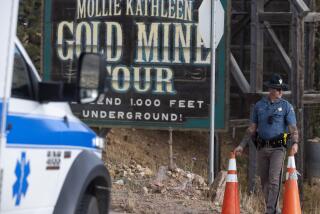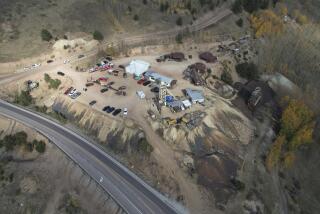Inspectors Found Many Problems on Tunnel Job
- Share via
Three weeks before a giant subway digging machine got stuck under the Santa Monica Mountains last month, parts of the tunnel were already caving in and shrinking seriously enough to alarm inspectors and slow excavation to a crawl, according to Metro Rail records obtained by The Times.
Reports filed from early June to mid-July after every shift by inspectors working for the county’s subway construction management firm describe such things as slumping ground, water showering in like “rainfall,” tunnel-support ribs that wouldn’t fit, and a laser-guidance system that repeatedly sent the digging machine briefly off course.
In several of the reports, obtained under the California Public Records Act, inspectors fretted over whether four-inch-wide steel ribs chosen by the contractor to support the tunnel in the last 210 feet of digging were strong enough or installed properly. On three days in mid-July after the mining had halted, an inspector called certain tunnel conditions “not very safe” or “very dangerous.”
The Metropolitan Transportation Authority reported Friday that miners have finally freed the 300-foot-long digging machine and that excavation of the tunnel, which stopped 1 1/2 months ago, will resume Monday.
When completed in 2000, the tunnel and a twin to be built alongside will ferry subway commuters from Studio City to Hollywood on the Red Line route between downtown and the San Fernando Valley.
A review of the inspection reports raises questions about whether the long, embarrassing interruption could have been avoided if the contractor or the MTA’s engineering consultants had foreseen the need for stronger tunnel supports before the digging machine was trapped. The MTA and contractor said the machine became lodged because of “squeezing” ground as it sat motionless over the four-day Fourth of July weekend.
The contractor, Indiana-based Traylor Bros./Frontier-Kemper, used six-inch ribs to support the first 730 feet of its tunnel, then switched to four-inch ribs for the next 210 feet.
*
An examination of the builder’s contract with the MTA shows that the four-inch-wide steel ribs were two inches narrower than the minimum width originally specified by design engineers.
MTA project manager Charles Stark confirmed that a panel of the agency’s construction executives and consulting engineers permitted the switch to the narrower steel because they believed that rock discovered during mining was firmer than tunnel designers expected.
Speaking of a representative for the contractor, Stark said: “He asked for a substitution and we allowed it.”
Most Red Line tunnels have been supported with thick rings of precast concrete. According to Stark, MTA consultants who designed the cross-mountain tunnel believed that Hollywood Hills sedimentary rock and granite would hold up better than the sand and soft rock that make up the Los Angeles Basin and San Fernando Valley floor.
The designers therefore gave contractors who bid on this job the option of supporting their tunnel with either thick rings of concrete, which are strongest but most costly, or with much lighter-weight steel ribs, Stark said.
Since the digging machine’s entrapment, the MTA has ordered Traylor Bros. to replace 44 of the four-inch-wide steel tunnel support ribs with stronger six-inch supports. Only eight sets of four-inch steel ribs will remain in the tunnel, Stark said.
According to three experts who have evaluated the inspection reports for The Times, the problems described are not typical of most underground excavation operations.
The three authorities, all veteran miners or construction executives, asked not to be identified. One works for a Metro Rail contractor, another for a state inspection agency and the third owns a private mining business.
Said one: “This whole setup, using four-inch steel ribs in soft rock, sounds crazy. . . . I can’t understand why [the MTA] didn’t shut the operation down and come up with another support system.”
Said another: “They can limp along doing it this way and make it work by [spraying concrete in the tunnel] and adding extra sets of bigger steel--it just costs money. The slower you go the more it costs. The question is who will pay.”
In the MTA’s defense, Z. Daniel Eisenstein, a University of Alberta civil engineering professor and head of the agency’s tunnel advisory panel, said he found nothing wrong with the MTA’s decision to originally allow Traylor to use four-inch ribs “as long as they were properly installed.”
He dismissed the troubles described in the inspection reports as no more serious than a “flat tire” at the start of a long auto trip. MTA officials also point out that no miners have suffered major injuries and that the tunnel has never been in danger of collapsing.
Traylor Bros., which is based in Indiana and considered one of the nation’s top construction firms, is forbidden by its MTA contract from talking to the news media. JMA, the consortium of engineering firms supplying inspectors to oversee the quality of Traylor Bros.’ work, is likewise unable to comment.
The MTA has declined to estimate the cost of the delay, but industry experts peg it at a minimum of $40,000 a day, or at least $1.6 million so far. It has not been determined whether the MTA or Traylor Bros. will pay for the costs of the repairs and delay.
Although no workers have been killed in the decade-long construction of the subway, the project has suffered safety problems--from underground fires and runaway trains to near-escapes from a gaping Hollywood Boulevard sinkhole. Traylor Bros. was cited for three violations of state safety laws classified as “serious” by the California Division of Occupational Safety and Health in June.
Only once in the month and a half of reports on the cross-mountain tunnel examined by The Times did an inspector make an unequivocally upbeat remark on the excavation. “This was a good shift for the contractor. No voids, ground looking better,” one inspector wrote about the June 24 swing shift.
The next day, however, miners were forced to spend five hours setting a single ring of steel support ribs in place--a job that normally takes less than 30 minutes. And then an underground train car derailed as it carried away muck, halting work for hours.
The inspectors’ reports--which are not given to MTA construction executives--recite a litany of woes.
Observations of unstable sandstone that crumbled, forming giant voids that had to be stuffed with pieces of timber and a concrete-like mixture called shotcrete, are frequent in the reports.
At the same time, according to the reports, water occasionally rained from rock fissures into the tunnel at a rate of 30 gallons a minute. That was not a lot, according to Eisenstein. But it was enough to turn the rock into a slippery goo that gummed up the contractor’s hard-rock digging machine and dirt-hauling conveyor belt, according to the reports. Miners were often forced to shovel the muck by hand into five-gallon buckets for removal.
During the June 4 overnight shift, inspector Sandor Dorogi wrote: “Water is coming in . . . Traylor Bros. made the effort with grout to slow it down but have had no luck. Hand mucking is ongoing.”
During the June 12 evening shift, inspector Amarat Wipaghathagit wrote: “Mining stopped [after] approximately two feet because of caving-in of ground from the right side . . . and the ground [kept] caving in.”
During the June 19 night shift, Wipaghathagit wrote: “Observed many places of ground breaking on the left side of the [top of the tunnel]. . . . New wire mesh support could not hold the ground, which created many deep pocket saggings.”
Ideally, Stark said, Metro Rail tunnel contractors are expected to advance an average of 100 feet a day. But in the first 940 feet of what will ultimately be a 2.3-mile tunnel, Traylor Bros. only once advanced as much as 50 feet a day, records show.
Blame for the pace can be partially attributed to problems that are typical at the start of a job, the experts said. Yet difficulty in installing the steel ribs, the experts agreed, apparently was the result of a failure by design engineers to foresee that the heavily faulted crushed shale in the area would compress into the tunnel.
Stark said their engineers have not concluded a study to determine what went wrong. In the past, he has told the agency’s board of directors that he believes the mining released “stored compressive energy” in a fold of shale only in the 60-foot stretch where the tunneling machine became wedged in the mountain. He also said the size of the tunnel had “relaxed,” or moved in several inches, only in that particular section.
However, from June 20 to the day before the holiday weekend, inspectors were noting that miners were having a very hard time installing the support ribs. In many cases, by the time the digging machine stopped, the diameter of the tunnel had shrunk as the ground compressed into the tunnel.
On June 24, inspector Arthur Glaubert wrote during the day shift: “Contractor was very slow installing ring sets because he could not expand them without removing [two inches of ground] from the lower sides of the tunnel.”
By the beginning of July, matters took a turn for the worse, according to the inspection reports.
During the July 2 day shift, Glaubert reported: “Miner got hit with a [piece] of hard ground . . . which fell off east side of the tunnel wall. He was conscious but not feeling good and [immediately] taken to the hospital.” (The miner returned to work later that day, an MTA spokesman said.)
During the next shift, Dorogi wrote: “East and west walls need support. Rocks, muck, spoil falling as the TBM moves. It’s a hazard.”
The following night, Wipaghathagit reported that mining could not proceed because ribs “did not fit in the available space” and one “buckled . . . because of expanding pressure.”
Miners took the next four days off to celebrate Independence Day, and the tunneling machine--which they have nicknamed Thelma--sat idle.
*
On Monday, July 8, Traylor Bros. workers and inspectors returned to find that several sections of the cement floor had pushed up from the ground. Five steel ribs were classified by an inspector as “twisted, badly twisted and very badly twisted, buckled and out of shape.”
Traylor Bros. stopped mining forward and began to replace twisted four-inch-wide ribs with six-inch ribs, shoring up large gaps in the rock with shotcrete and timber.
In the meantime, however, some conditions became more hazardous, the inspection reports said. On July 12, Glaubert wrote that a 68-foot stretch of the tunnel “is not very safe because of possible loose falling chipped rocks.”
The next day, inspector Robert Santa Cruz wrote: “Four-inch steel not sufficient strength for squeezing ground.” He added: “Precautionary measures to secure this wall area should be taken.”
Two days later, on July 15, Glaubert called the area “very dangerous--loose, falling rock.” The next day he wrote that the contractor had made the tunnel safer.
Local politicians who govern the $5.9-billion subway project were kept in the dark about the troubles until July 18, when MTA construction executive officer Stanley Phernambucq appeared along with Stark and Eisenstein before the board of directors.
Stark told the board that the “squeezing ground” that trapped the digging machine was “unexpected but not unheard of” and that he believed the contractor would resume mining that afternoon.
More to Read
Sign up for Essential California
The most important California stories and recommendations in your inbox every morning.
You may occasionally receive promotional content from the Los Angeles Times.










